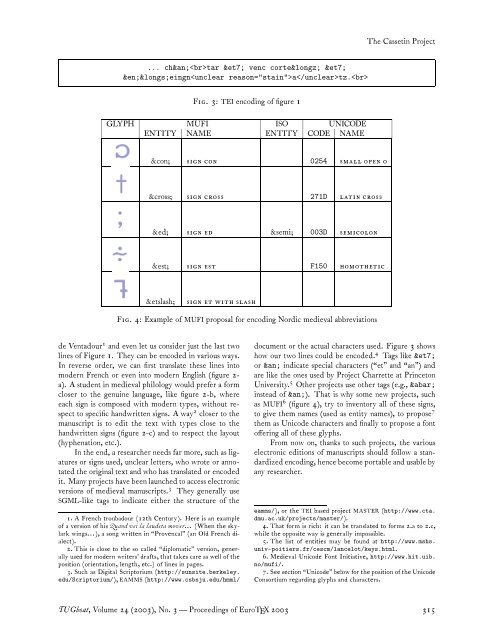The Cassetin Project — Towards an Inventory of Ancient ... - TUG
The Cassetin Project — Towards an Inventory of Ancient ... - TUG
The Cassetin Project — Towards an Inventory of Ancient ... - TUG
Create successful ePaper yourself
Turn your PDF publications into a flip-book with our unique Google optimized e-Paper software.
... ch&<strong>an</strong>;tar &et7; venc corte&longz; &et7;<br />
&en;&longs;eingnatz.<br />
Fig. 3: TEIencoding<strong>of</strong> figure1<br />
GLYPH MUFI ISO UNICODE<br />
ENTITY NAME ENTITY CODE NAME<br />
&con; sign con 0254 small open o<br />
✗ sign cross 271D latin cross<br />
&ed; sign ed ; 003D semicolon<br />
&est; sign est F150 homothetic<br />
&etslash; sign et with slash<br />
Fig. 4: Example <strong>of</strong> MUFIproposal for encodingNordic medievalabbreviations<br />
de Ventadour 1 <strong>an</strong>d even let us consider just the last two<br />
lines<strong>of</strong> Figure1. <strong>The</strong>yc<strong>an</strong> beencodedin variousways.<br />
In reverse order, we c<strong>an</strong> first tr<strong>an</strong>slate these lines into<br />
modern French or even into modern English (figure 2a).<br />
Astudentinmedievalphilologywouldpreferaform<br />
closer to the genuine l<strong>an</strong>guage, like figure 2-b, where<br />
each sign is composed with modern types, without respectto<br />
specifich<strong>an</strong>dwrittensigns. Away 2 closerto the<br />
m<strong>an</strong>uscript is to edit the text with types close to the<br />
h<strong>an</strong>dwritten signs (figure 2-c) <strong>an</strong>d to respect the layout<br />
(hyphenation,etc.).<br />
Intheend,aresearcherneedsfarmore,suchasligatures<br />
or signs used,unclear letters,who wrote or <strong>an</strong>notatedtheoriginaltext<strong>an</strong>dwhohastr<strong>an</strong>slatedorencoded<br />
it. M<strong>an</strong>yprojectshavebeenlaunchedtoaccesselectronic<br />
versions <strong>of</strong> medieval m<strong>an</strong>uscripts. 3 <strong>The</strong>y generally use<br />
SGML-like tags to indicate either the structure <strong>of</strong> the<br />
1. A French troubadour (12th Century). Here is <strong>an</strong> example<br />
<strong>of</strong> a version <strong>of</strong> his Qu<strong>an</strong>dveilalaudetamover... (When the skylark<br />
wings...), a song written in “Provencal” (<strong>an</strong> Old French dialect).<br />
2. This is close to the so called “diplomatic” version, generallyusedformodernwriters’drafts,thattakescareaswell<strong>of</strong>the<br />
position (orientation, length, etc.) <strong>of</strong> lines in pages.<br />
3. Such as Digital Scriptorium (http://sunsite.berkeley.<br />
edu/Scriptorium/), EAMMS (http://www.csbsju.edu/hmml/<br />
<strong>The</strong><strong>Cassetin</strong> <strong>Project</strong><br />
document or the actual characters used. Figure 3 shows<br />
how our two lines could be encoded. 4 Tags like &et7;<br />
or &<strong>an</strong>; indicate special characters (“et” <strong>an</strong>d “<strong>an</strong>”) <strong>an</strong>d<br />
are like the ones used by <strong>Project</strong> Charrette at Princeton<br />
University. 5 Otherprojectsuseothertags(e.g.,&abar;<br />
instead <strong>of</strong> &<strong>an</strong>;). That is why some new projects, such<br />
as MUFI 6 (figure 4), try to inventory all <strong>of</strong> these signs,<br />
to give them names (used as entity names), to propose 7<br />
themas Unicodecharacters <strong>an</strong>d finallyto propose a font<br />
<strong>of</strong>feringall <strong>of</strong> theseglyphs.<br />
From now on, th<strong>an</strong>ks to such projects, the various<br />
electronic editions <strong>of</strong> m<strong>an</strong>uscripts should follow a st<strong>an</strong>dardizedencoding,hencebecomeportable<strong>an</strong>dusableby<br />
<strong>an</strong>yresearcher.<br />
eamms/), or the TEI based project MASTER (http://www.cta.<br />
dmu.ac.uk/projects/master/).<br />
4. That form is rich: it c<strong>an</strong> be tr<strong>an</strong>slated to forms 2.a to 2.c,<br />
while the opposite way is generally impossible.<br />
5. <strong>The</strong> list <strong>of</strong> entities may be found at http://www.mshs.<br />
univ-poitiers.fr/cescm/l<strong>an</strong>celot/keys.html.<br />
6. Medieval Unicode Font Initiative, http://www.hit.uib.<br />
no/mufi/.<br />
7. Seesection“Unicode”belowfortheposition<strong>of</strong>theUnicode<br />
Consortium regarding glyphs <strong>an</strong>d characters.<br />
<strong>TUG</strong>boat,Volume24 (2003), No.3—Proceedings<strong>of</strong> EuroTEX2003 315

















